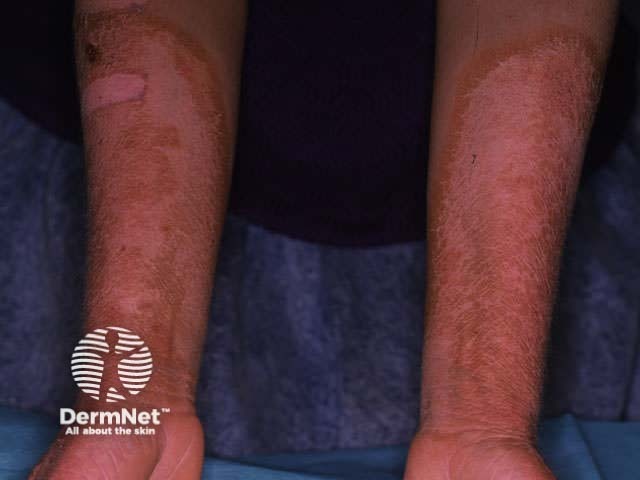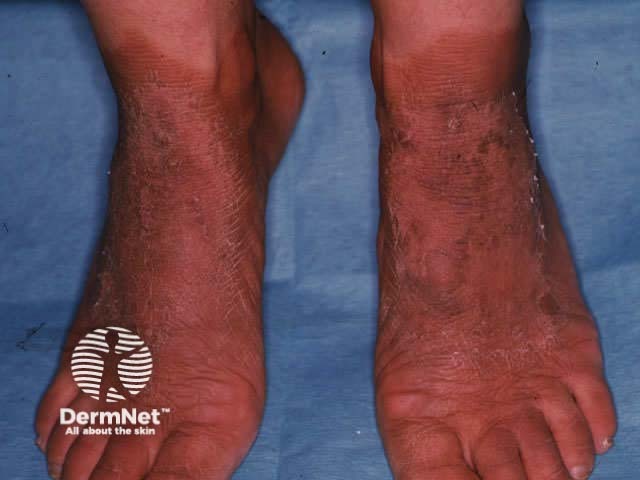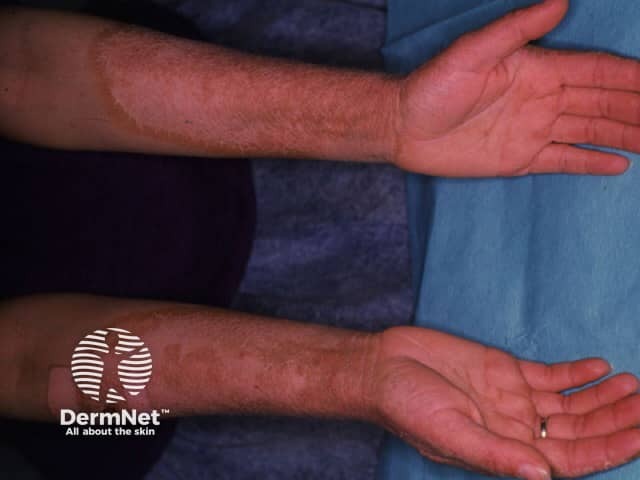Main menu
Common skin conditions

NEWS
Join DermNet PRO
Read more
Quick links
Authors: Vanessa Ngan, Staff Writer, 2003; Updated: Casey P Schukow, Medical Student, Michigan State University College of Osteopathic Medicine, Detroit, MI, United States of America; Dr Martin Keefe, Dermatologist, Christchurch, New Zealand. Copy edited by Gus Mitchell. June 2021
Introduction Demographics Causes Clinical features Complications Diagnosis Differential diagnoses Treatment Outcome
Pellagra is a systemic disease caused by vitamin B3 (niacin) deficiency. It is characterised by the 4 D’s — dermatitis, diarrhoea, dementia and, if untreated, death. The name ‘pellagra’ is derived from the Italian ‘pelle agra’ meaning sour or rough skin.

Pellagra

Pellagra
Primary pellagra due to a deficient diet is common particularly in developing countries where corn (maize) is a major food source or following prolonged disasters including famine or war. Although corn is rich in niacin, it is in a bound form unable to be accessed unless treated with alkaline solutions, and the proteins in corn are low in tryptophan. Pellagra remains endemic in India, China, and some African countries.
In developed countries many foods, such as bread and cereal, are fortified with niacin, making pellagra rare. However severe food restriction can still result in pellagra and other signs of malnutrition such as may occur with chronic alcohol abuse, anorexia nervosa, or self-imposed diets. Alcoholism is the commonest cause of pellagra in developed countries.
Secondary pellagra develops despite an adequate diet due to:
A form of pellagra is seen in Hartnup disease (MIM 234500), an autosomal recessive inherited disorder of the SLC6A19 gene resulting in impaired absorption of tryptophan from the bowel and excessive excretion by the kidneys.
Pellagra is the result of niacin deficiency. Half of the body’s niacin requirement comes from dietary intake of niacin. The other half is synthesised in the body from the amino acid tryptophan. Niacin is found in many animal products (as nicotinamide) and plants (as nicotinic acid). A varied diet including milk, eggs, red meat, poultry, fish, peanuts, legumes, and seeds provides sufficient niacin and tryptophan.
Niacin is essential for maintaining cell function. It is a component of nicotinamide adenine dinucleotide (NAD) and nicotinamide adenine dinucleotide phosphate (NADP) required by over 100 enzymes involved in the metabolism of carbohydrates, fats, proteins, and alcohol, as well as DNA repair and cell signalling. Therefore, tissues with a high energy requirement or cell turnover rate such as the skin, bowel, and brain are those affected by pellagra.
Pellagra is remembered as the 4 D’s – dermatitis, diarrhoea, dementia, and eventually death. However not all signs develop in every patient. Skin changes are often the first sign, appearing in spring and summer.

Casal necklace

Pellagrous boot

Pellagra dermatitis on forearms
The erythema of pellagra may be less obvious in skin of colour.
The diagnosis of pellagra should be considered based on the clinical features in an appropriate setting. Investigations such as blood tests and skin biopsy are not diagnostic but may be used to exclude other diagnoses.
The rapid response to niacin supplementation usually confirms the diagnosis.
Hartnup disease is diagnosed on the detection of neutral amino acids in the urine.
The differential diagnosis for the mucocutaneous clinical features of pellagra may include:
The WHO recommends at least 300 mg nicotinamide in an oral divided daily dose for 3–4 weeks to treat pellagra. Nicotinamide is recommended due to niacin-induced flushing. Additional dietary supplements may be required for general malnutrition and cachexia. Ongoing niacin supplements may be required.
Hartnup disease requires niacin supplements and high protein diet, as well as sun protection lifelong.
Symptoms and signs of pellagra show significant improvement within one week of starting niacin supplements. The diarrhoea and mucosal changes are the first to improve within days. The skin changes typically resolve within two weeks. Full recovery in chronic cases may take longer.
Hartnup disease has a good prognosis with treatment and symptoms tend to improve with age.